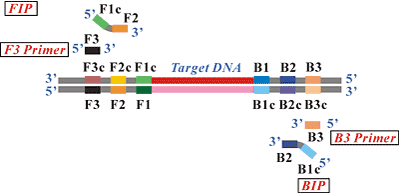- TOP
- About LAMP
- Design of primers
Design of primers
Design of primers
Design 4 types of primers (described in detail below) based on the following 6 distinct regions of the target gene: The F3c, F2c and F1c regions at the 3' side and the B1, B2 and B3 regions at the 5' side.

FIP
Forward Inner Primer (FIP) consists of the F2 region (at the 3' end) that is complementary to the F2c region, and the same sequence as the F1c region at the 5' end.
F3 Primer
Forward Outer Primer consists of the F3 region that is complementary to the F3c region.
BIP
Backward Inner Primer (BIP) consists of the B2 region (at the 3' end) that is complementary to the B2c region, and the same sequence as the B1c region at the 5' end.
B3 Primer
Backward Outer Primer consists of the B3 region that is complementary to the B3c region.
Main points of primer design
Proper primer design is crucial for performing LAMP amplification. The above primer regions can be determined by using the PrimerExplore (a special software to design LAMP primers) after considering the base composition, GC contents and the formation of secondary structures. Tm value can be obtained by Nearest Neighbor method. The following is the main points of primer design.
1.Distance between primer regions
- The distance between 5' end of F2 and B2 is considered to be 120-180bp, and the distance between F2 and F3 as well as B2 and B3 is 0-20bp.
- The distance for loop forming regions (5' of F2 to 3' of F1, 5' of B2 to 3' of B1) is 40-60bp.
2.Tm value for primer regions
- About 60-65°C in the case of GC rich and Normal, about 55-60°C for AT rich.
3.The stability of primer end
- The dG calculated on 6bp from the following end regions should be less than -4kcal/mol, 5' end of F1c/B1c and 3' end of F2/B2 as well as F3/B3.
4.GC contents
- About 50-60% in the case of GC rich and Normal, about 40-50% for AT rich.
5.Secondary structure
- Primers should be designed so as not to easily form secondary structures. 3' end sequence should not be AT rich or complementary to other primers.
6.Others
- If the restriction enzyme sites exist on the target sequence, except the primer regions, they can be used to confirm the amplified products.
Click here to start primer design
We have received various inquires about primer design, in some cases, negative samples were amplified, or non-specific reactions were observed. Reasons for these cases might include: (1) contamination has occurred. (2) primer dimmers were formed and from this the amplification proceeded. In the case of (1), changing to new reagents, instruments and equipments can help to avoid contamination. However, in case (2), as primers were not designed properly, re-design of the primers is needed.